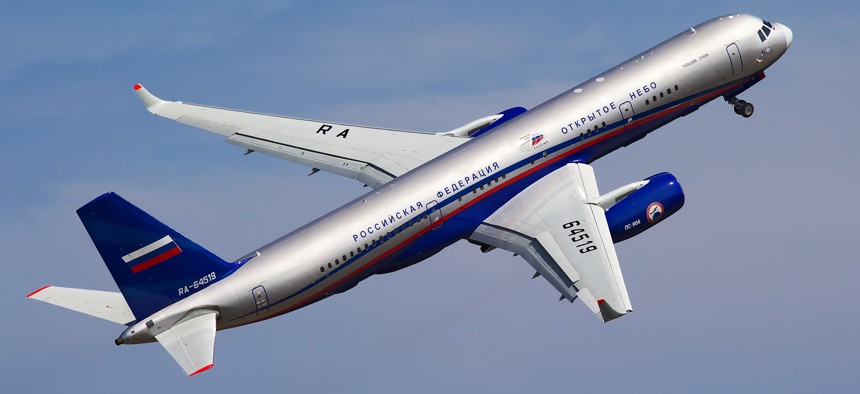
Russia's Tu-214ON Open Skies aircraft flies at the MAKS-2011 airshow outside Moscow. Oleg V. Belyakov/AirTeamImages CC3.0 via Wikimedia Commons
Let Russia's Planes Keep Flying Over US, Just Like Ike Wanted
The Pentagon dithered while Moscow upgraded. It’s time to catch up — not scrap the Open Skies Treaty.
President Dwight D. Eisenhower had a decision to make after the Soviet Union launched Sputnik. He could accept the Kremlin’s right to traverse space above the United States or resolve to deny this form of intelligence gathering through military means. Ike chose to accept increased transparency rather than place future leaders of both countries on a collision course toward warfare in space.
Ike made this choice over the misgivings of senior military officers, but his reasoning was sound: The Soviet Union was a closed society, and U.S. policy makers and intelligence officials would have more to gain than to lose by accepting mutual transparency. Using this same logic, Ike also proposed an “Open Skies” agreement for cooperative aerial observation flights, but this was unacceptable to the Kremlin.
When Mikhail Gorbachev tried to reform the Soviet Union through glasnost, or openness, President George H.W. Bush revived Ike’s idea of Open Skies. Gorbachev — who had already permitted foreign observers at Soviet military exercises and responded to Ronald Reagan’s “trust but verify” challenge by accepting intrusive missile inspections — allowed negotiations to proceed. It took more than a decade, but in 2002, 45 years after Ike’s proposal, the Open Skies Treaty went into effect. Cooperative aerial observation flights began from Vancouver all the way to Vladivostok.
Times have changed. Vladimir Putin isn’t Mikhail Gorbachev, Russia has pushed back hard against NATO expansion, and senior U.S. military officers wonder aloud whether the Open Skies Treaty now helps Russia more than the West. STRATCOM Commander Adm. Cecil Haney says, “The treaty has become a critical component of Russia’s intelligence collection capability directed at the United States.” DIA Director Lt. Gen. Vincent Stewart adds, “The Open Skies construct was designed for a different era…I’m very concerned about how it’s applied today.” At the center of their concerns: Russian observation flights are equipped to fly a new sensor suite, while the United States isn’t.
There are sound grounds to complain about Russian behavior under the Open Skies Treaty. Even so, the value of cooperative observation flights increases in troubled times. Amid last year’s rising tensions, the U.S. Open Skies aircraft carried out twice as many overflights as its Russian counterpart. U.S. flights have strengthened ties between NATO members and have reassured non-NATO states around Russia’s periphery. Under the Treaty’s “ride-sharing” provision, U.S. flights over Russia in 2015 carried crew members from Ukraine, Canada, France, Germany, the Czech Republic, Great Britain, Turkey, Italy and Romania.
Moreover, complaints about the new Russian advantage under Open Skies may be overblown and are certainly misdirected. The Kremlin isn’t the culprit in this case; the Pentagon is.
All sensors carried by Open Skies aircraft employ unclassified, commercially available technology. There are agreed safeguards and procedures for certifying capabilities and for making sure that observation flights are not carried out in a manner that would exceed approved sensor capabilities. Among these safeguards: all sensors must be approved by all parties, host country representatives are allowed on Open Skies flights, and the data collected are shared.
When the Treaty was first negotiated, participating states approved the use of panoramic and framing cameras using film, video cameras, infra-red line-scanning devices and sideways-looking synthetic aperture radar – all far less capable than what was then available to intelligence agencies. The maximum ground resolution acceptable with treaty-approved cameras is 30 centimeters. Today, anyone can buy commercial satellite imagery with a resolution of 25 centimeters.
The Treaty has provisions to upgrade and modernize sensors. Film has long ago given way to digital imagery. Treaty members have agreed to allow a digital electro-optical sensor package upgrade, but not to allow Open Skies flights to operate so that higher resolution can be obtained. Still, Gen. Stewart is concerned that Russia will be able to gain a “significant” advantage if the United States continues to rely on the old film system.
So why doesn’t the U.S. military add its own digital sensors? Because the Pentagon dropped the ball. A policy directive to proceed with the upgrade was issued in 2012, but the Defense Department didn’t issue a request for proposal until 2015, and still hasn’t chosen a contractor. The issue isn’t money – perhaps $45 million. The problem is that Open Skies flights are a very low priority for the Pentagon.
As global tensions rise, the instincts and advice of Presidents Eisenhower, Reagan, and Bush remain true. Betting on mutual transparency is still a wise decision and a winning proposition for the United States. At a time when the Pentagon is embarked on a new $3 billion initiative to reassure European friends and allies worried about Russian belligerence, it makes sense to speed up equipping the U.S. Open Skies plane with digital imaging capabilities, rather than to complain about the disadvantages of mutual transparency.



